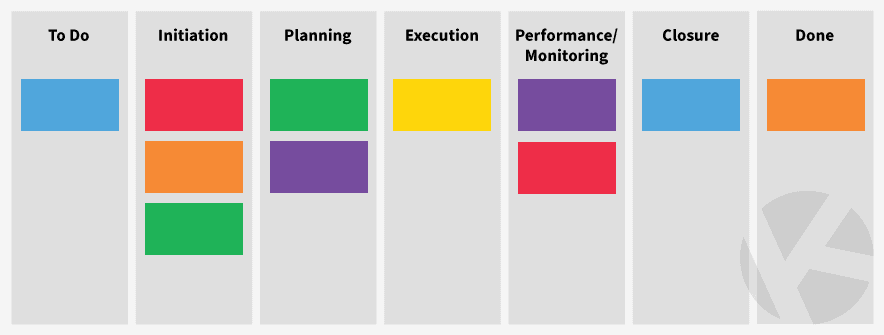Project Management Kanban
Project management can be approached using many different methodologies and tools. Still, if you are seeking to visualize a project while continuously improving during the project, then Kanban is the ideal choice. Let us explain…

The benefits of using Kanban for project management
Here are a few examples of standard practices used in Kanban that can help you avoid common project management mistakes: breaking down projects into smaller tasks, clearly prioritizing these tasks, focusing on reviewing and improving your process, etc.
Ultimately, using Kanban will provide insights from the world of Lean Thinking to introduce new ways of improving how to deliver projects more efficiently. Below are the Top 5 benefits of Kanban for project management.
- Visibility and Transparency for Better Workflow Management
- Flexibility and Responsiveness
- Shortened Cycle Times = Increased Output
- Resource Allocation and Budget and Waste Reduction
- Continuous Improvement and Delivery
There are many more reasons why you should use a Kanban board. At a minimum, it can help keep project tasks organized visually. We also strongly believe that when a team can focus on seeing everything needed on a single Kanban board, it can naturally improve team collaboration and communication.
Ultimately, leveraging the Kanban method for project management will make the journey as important as the destination. It will promote the spirit of Kaizen to improve every aspect of project management continuously. This mindset will have the ultimate benefit of increasing efficiency.
Applying the 4 Kanban principles to project management
Kanban provides these 4 principles listed below that can easily be applied to the art of project management.
- Start with what you’re doing now
- Agree to pursue incremental, evolutionary change
- Respect the current process, roles, responsibilities, and titles
- Encourage acts of leadership at all levels
In essence, applying these Kanban principles to project management is not intrusive and will not cause any radical changes to how you deliver projects. Half of these principles are about not “rocking the boat” by continuing to work the way you do now and respecting everything in place. Although this might sound like a status quo, it’s a healthy way to establish a clear “as is” state that can be reviewed and improved by embracing the other half of the Kanban principles… Agreeing to pursue incremental, evolutionary change by proposing a “to be” state and getting there by encouraging acts of leadership at all levels, which is the key premise in Agile of empowering people.
Building high-performing teams
When looking at the key project dimensions: Time, Scope, Budget, we believe that Team Efficiency is a critical 4th dimension. One of the biggest challenges when transforming an organization from Waterfall to Agile is to promote the idea of keeping teams together.
Without an Agile mindset, teams are assembled for a specific project, and people are used in a matrixed environment, where most members of the project team are also working on multiple other projects. This is not efficient because people can’t accurately report or commit to a percentage for multiple projects all happening at the same time. Inevitably, one (or more) of these multiple projects will get a higher priority or critical issue derailing the best plans.
Agile teams are meant to stay together during the forming – storming – norming – performing model of group development introduced by Bruce Tuckman. By continuously working and learning from each other, the team becomes stronger and more predictable. Therefore, instead of pillaging teams by extracting members for a specific project, projects are presented to already performing teams that can more naturally deliver work that is familiar to their area of expertise. This is what we call Agile, moving from Project Focus to a Product focus and, ultimately, a customer focus.
Although Kanban does not prescribe particular roles, we have seen benefits with roles like a Service Delivery Manager and/or Service Request Manager in some instances of using Kanban for project management.

Designing the ideal Kanban board for project management
If you are ready to design your first Kanban board, we can show you how to create a Kanban board for any project, but if you are seeking to truly leverage Kanban across your organization, then you will want to also consider setting up a Portfolio Kanban system.
The simplest form of Kanban for project management is to map your current process as columns on a board. For example, if we use the Project Management Institute (PMI), five phases of project management are listed below:
Initiation > Planning > Execution > Performance/Monitoring > Closure
We can create a simple board that would look like this:
To Do > Initiation > Planning > Execution > Performance/Monitoring > Closure > Done

The sheer act of visualizing goals can help improve your team’s productivity. Kanban Zone provides many board templates that can be used as a starting point to visualize your process on a Kanban board. In fact, the Waterfall methodology can easily be mapped to a Kanban board.
The future of project management with Kanban
We believe that Kanban is reshaping the future of Project Management. From managing distributed teams with a different kind of virtual workforce to measuring progress and success with simple Kanban metrics, the Kanban approach to project management will, at a minimum, provide new ways of improving the way to deliver projects on time and with high quality. To make the most of it, be sure to choose a Kanban software solution that meets all of your needs.
There are also other techniques like Lean Six Sigma that we also recommend to blend with Kanban to create a match made in project management heaven.




